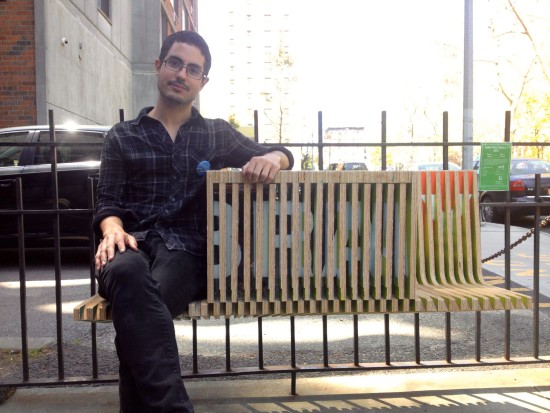Through its thousands of small book shelters worldwide, The Little Free Library organization intends to promote literacy while developing and reinforcing the community. Little Free Library readers are encouraged to bring their own books to exchange with those that were left by an earlier patron.
Recently Little Free Library has taken Manhattan. Chat Travieso was among only ten artists/designers chosen to have his design displayed for the Architectural League‘s and PEN World Voices Festival‘s Little Free Library NYC competition: his design is installed at 82 Rutgers Slip, in the Two Bridges neighborhood of Manhattan.
Chat and I met at his newly constructed book shelter to talk about both the premise and longevity of these small architectural works. All of the winning little libraries will be on display around Manhattan until September 1st, 2013.
Guernica: What type of books are you including inside the Little Free Library?
Chat Travieso: First of all I should say it’s a partnership between the Architectural League of New York, PEN World Voices festival, and the Little Free Library organization—they picked ten artists and partnered each artist with a different community organization, and PEN is providing the books. When I was in the planning stages with my community partner, which is the Two Bridges Neighborhood Council, we talked about all different types of books that would be appropriate for the population that lives here, which is a very diverse and ranges in age as well as ethnicity. We were specific about asking for books for children, as well as books for older people and books in different languages, such as Spanish, Chinese, and English.
Guernica: What’s the biggest hope for what this project will turn into?
Chat Travieso: I want this to work the way it’s supposed to work—I hope people enjoy it and use it—I hope people read and exchange books. The piece has seats attached to it, so I hope people use the seats. And they’re facing the waterfront. The East River waterfront is an area often overlooked. Not for the people in this community; everyone in this community sees it everyday and walks along the waterfront. There’s still a lot of construction going on here, so it’s not an ideal view. But, it’s still the water, and l think there’s something calming about the water.
A big part of this project is that the design is open-sourced—it can be replicated everywhere.
Guernica: In light of Sandy, are you concerned at all about the integrity of the structure lasting through a hurricane or some other super storm?
Chat Travieso: The piece doesn’t touch the ground, and that was something that I was pretty interested in from the beginning, that the work would be attached to an existing structure from the area. By not touching the ground, if there is flooding, hopefully it wouldn’t really affect the piece or the books. If it’s something like super storm Sandy, it might be another scenario, but I hope so. You never know, the climate is unpredictable now. But, let’s say yes.
This area was hit hard by the storm. They had really bad flooding here. A lot of the subsidized housing here didn’t have power for over a week, longer than most of New York. Most of New York got their power back in five to seven days. This area didn’t have power for about two weeks.
Guernica: Would you want to replicate this around the rest of Manhattan? Would it be possible to use these same materials in other neighborhoods?
Chat Travieso: A big part of this project is that the design is open-sourced. So they’re going to have the construction documents and rendering source up on the Architectural League’s website, so it can be replicated everywhere. This design is specific to the railing, but you can always adjust the design. It can be replicated, and I hope it is replicated all over the city.
Guernica: Were community members involved in building the structure?
Chat Travieso: Yes, we had students from the Two Bridges after-school program come up with ideas for what colors we should paint it. The students helped me trace the letters and paint the sides of the piece. I wanted them to be a big part of this, because in the end, they’re going to be the stewards of this thing. They’re going to taking care of it.
